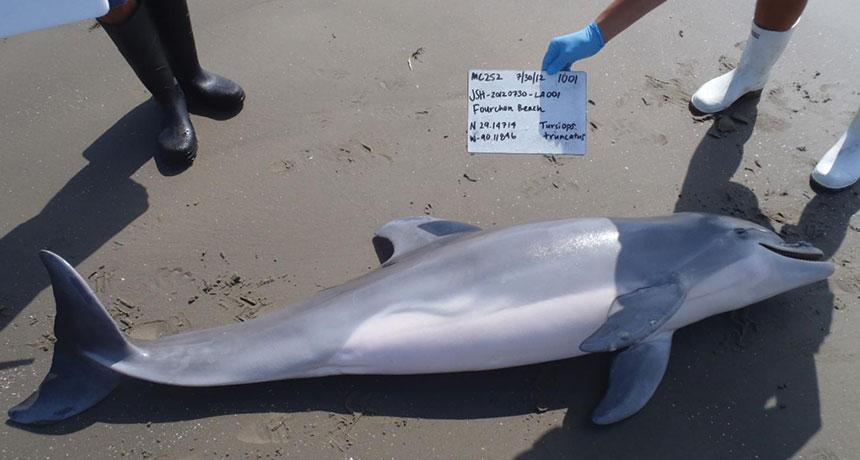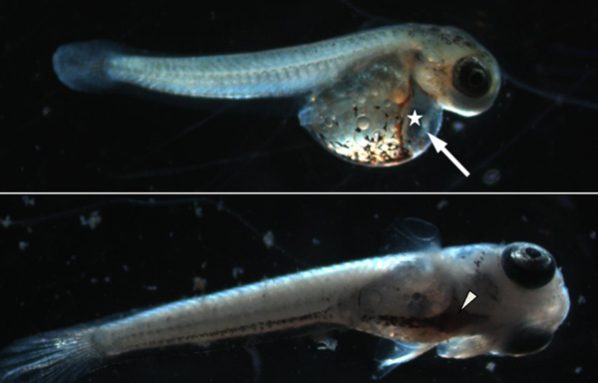Gulf oil spill: Still poisoning dolphins to crickets
Dead bottlenose dolphins had damage to lungs and other tissues, types previously linked to oil exposures

This bottlenose dolphin was found dead in the Gulf of Mexico in July 2012. It may be one of more than 1,000 that appear to have died from poisoning related to oil spilled as a result of the 2010 Deepwater Horizon well blowout.
Louisiana Department of Wildlife and Fisheries
By Beth Mole
Scientists have just linked a massive, ongoing die-off of dolphins in the Gulf of Mexico with the April 2010 Deepwater Horizon oil spill. But that’s not the only fallout from this spill, one of the biggest in U.S. history. Oozing oil is a recurring yet hard-to-control problem on marshes in a bay just south of New Orleans. One day, a patch of the wetland is green and lush. The next it’s drenched in thick, noxious goo.
And that surfacing oil is releasing toxic vapors. Biologists caged crickets and floated them in and around the bay’s marsh. And they’re dying. Even now.
Researchers don’t know what chemical or mix of pollutants is wafting from the oil to kill the crickets. “It’s this huge mystery,” says Linda Hooper-Bùi. She’s an environmental scientist at Louisiana State University in Baton Rouge. But if the fumes can kill insects, she wonders what can they do to people on the marsh? “It keeps me up at night,” she says.
The spill started when an explosion and flames erupted after a blowout on an offshore oil rig. The April 20 blast killed 11 men. It also triggered an 87-day eruption of hydrocarbons. Some 5 million barrels (10 million gallons) of oil and hundreds of thousands of metric tons of natural gas gushed from the well. The pollution spewed up from the seafloor, roughly 1,500 meters (almost a mile) below sea level.
A new study has focused on dead bottlenose dolphins (Tursiops truncatus) that turned up in the Gulf. Following the blowout at BP’s Deepwater Horizon drill rig, researchers have tracked a rising number of unusual deaths and health issues in Gulf dolphins. But nailing the spill as their cause has not been easy.
Stephanie Venn-Watson works for the National Marine Mammal Foundation in San Diego, Calif. As a veterinary epidemiologist, she headed a research team to probe dolphin deaths.
Her team collected dead dolphins from the Louisiana, Mississippi and Alabama coasts between June 2010 to December 2012. They also examined records for 106 other dolphin deaths clearly not related to the spill. Those others had died before the spill or in areas not affected by the spill.
After the spill, some dead Gulf dolphins had problems with their adrenal glands, the researchers found. Of dolphins from the spill zone, 33 percent had thinning of their adrenal glands’ cortex. This is a region that produces hormones essential for regulating metabolism and other functions. Only 7 percent of dead dolphins from the other group had such thinning. Oil exposure has been linked with adrenal gland abnormalities in mink and some kinds of birds. Dolphin victims of the Gulf spill also had lung damage. This, too, had previously been linked to crude oil, the researchers reported May 20 in PLOS ONE.
So the recent dieoffs of dolphins in the Gulf areas affected by the spill must be due to oil, Venn-Watson says. “No feasible alternative causes remain that can reasonably explain the timing, location and nature of these distinct lesions and increase in deaths,” she explains.
The magnitude of injuries
Since early 2010, the number of Gulf cetaceans (dolphins, whales and porpoises) that are stranded — dead or in need of assistance — has nearly quadrupled. From 2002 to 2009, an average of about 74 cetaceans became stranded each year. As of May 31, 2015, the five-year toll had hit 1,398.
The newly reported damage could leave dolphins more vulnerable to infection and diseases, the researchers note. In fact, 22 percent of dolphins from the spill zone had bacterial pneumonia. (That’s an infectious lung disease that can kill.) This pneumonia rate is 10 times the level seen in dolphins outside the spill zone. The affected Gulf animals “had some of the most severe lung lesions I have ever seen in wild dolphins,” observes Kathleen Colegrove. She’s a veterinary pathologist of the University of Illinois at Urbana–Champaign. She was also a coauthor of the new study.

Dolphins may be particularly vulnerable to lung damage from oil spills at sea because the animals take deep breaths at the surface. They also often hold their breath for long periods, which could extend exposure to any toxic compounds they had inhaled, the authors note.
The lung and adrenal damage seen in these dolphins is distinct from what tends to be seen in other dolphin die-offs, says Michael Twiner. He’s a toxicologist of the University of Michigan–Dearborn. Overall, the study makes a convincing link between the Deepwater Horizon oil spill and the health problems seen in the dolphins, he says.
Geoff Morrell disagrees. He’s a senior vice president with BP (the company whose well had spilled all of that oil in the Gulf). “This new paper fails to show that the illnesses observed in some dolphins were caused by exposure to Macondo oil,” he said in a statement. Macondo was the name of BP’s drilling site in the Gulf.
Still, a host of research projects have shown that even relatively brief exposures to the oil released by that Gulf spill can harm sea life. It impaired reproduction in some fish. It created deformities in some fish that affected their later ability to swim. It prevented some fish eggs from hatching — even though the embryos inside had not died. And older oil — also known as “weathered” oil — often proved the most toxic.
Power Words
(for more about Power Words, click here)
adrenal glands Hormone-producing glands that sit at the top of the kidneys.
barrel A unit of measure for crude oil. It’s equal to 42 gallons.
blowout (in oil drilling) A type of drilling-rig accident where valves fail to shut a pipe used to bring oil to the surface from underground reservoirs. An explosive, high-pressure spewing of oil and gases from a blowout can continue for a prolonged period, polluting the environment.
cetaceans The order of marine mammals that includes whales, dolphins and porpoises. The baleen whales (Mysticetes) filter their food from the water with big baleen plates. The remaining cetaceans (Odontoceti) include some 70 species of toothed animals that include beluga whales, narwhals, killer whales (a type of dolphin) and porpoises.
crude oil Petroleum in the form as it comes out of the ground.
epidemiologist Like health detectives, these researchers figure out what causes a particular illness and how to limit its spread.
hormone (in zoology and medicine) A chemical produced in a gland and then carried in the bloodstream to another part of the body. Hormones control many important body activities, such as growth. Hormones act by triggering or regulating chemical reactions in the body.
hydrocarbon Any of a range of large molecules created by chemically bound carbon and hydrogen atoms. Crude oil, for example, is a naturally occurring mix of many hydrocarbons.
infection A disease that can spread from one organism to another.
lesion A tissue or part of the body that shows damage from injury or disease. Lesions come in all shapes and sizes, both inside the body and on its outside. A pus-filled wound on the skin is one example. Cells with holes in them or missing parts due to disease represent a totally different class of lesions.
metabolism The set of life-sustaining chemical reactions that take place inside cells and bigger structures, such as organs. These reactions enable organisms to grow, reproduce, move and otherwise respond to their environments.
mammal A warm-blooded animal distinguished by the possession of hair or fur, the secretion of milk by females for feeding the young, and (typically) the bearing of live young.
marine Having to do with the ocean world or environment.
marsh A low-lying wetland usually covered with grasses and shrubs, not trees. It’s a prime feeding and nesting ground for waterfowl.
natural gas A mix of gases that developed underground over millions of years (often in association with crude oil). Most natural gas starts out as 50 to 90 percent methane, along with small amounts of heavier hydrocarbons, such as propane and butane.
pathologist Someone who studies disease and how it affects people or other infected organisms.
pneumonia A lung disease in which infection by a virus or bacterium causes inflammation and tissue damage. Sometimes the lungs fill with fluid or mucus. Symptoms include fever, chills, cough and trouble breathing.
toxic Poisonous or able to harm or kill cells, tissues or whole organisms. The measure of risk posed by such a poison is its toxicity.
toxicology The branch of science that probes poisons and how they disrupt the health of people and other organisms. Scientists who work in this field are called toxicologists.
veterinary Having to do with animal health. A doctor who specializes in treating animals is a veterinarian.
weathering The process of breaking down rocks, soil and chemicals (such as crude oil). Weathering can be chemical, such as by oxidation (rust), or mechanical, such as by water, ice, or wind.







